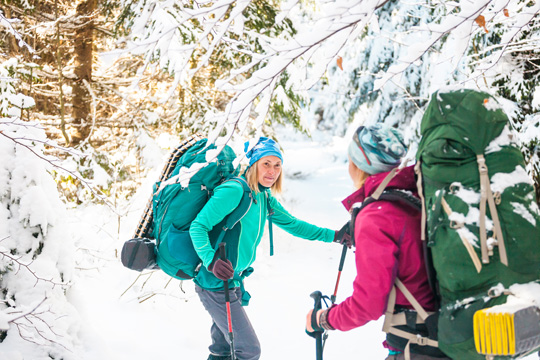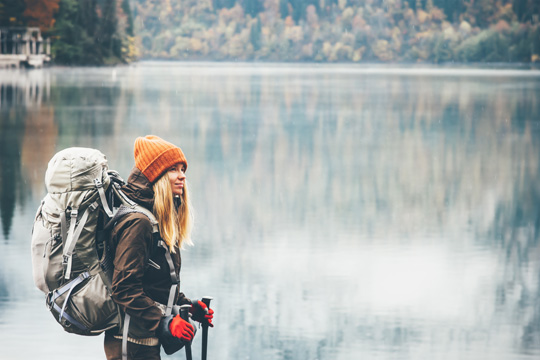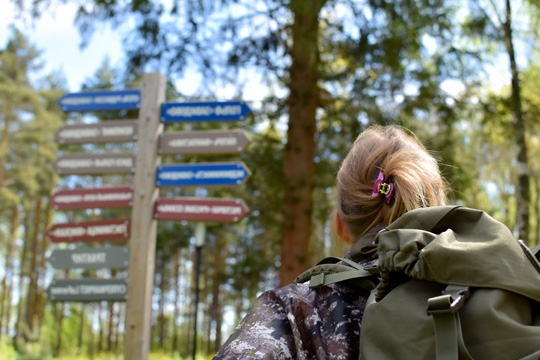
Identifying a true hiking enthusiast is often as straightforward as observing their weekend plans or a glimpse at their social media feed. Trailblazers, those who seek out paths less traveled, can be recognized by certain unmistakable signs.
Their passion for the great outdoors isn’t just a pastime; it’s a defining part of their identity. They are the ones who see a mountain range and immediately feel the pull to explore, who embrace the unpredictability of nature as a welcome challenge rather than an obstacle.
They are prepared for every trek, armed not just with a sturdy pair of boots but with an unwavering resolve to conquer new terrains. This readiness goes beyond physical preparations; it’s a mindset of enthusiasm and endurance.
Trailblazers understand that hikes are not measured solely by distance or elevation gain, but by the experiences and self-discovery they entail.
With an insatiable appetite for adventure, true hiking enthusiasts often become informal ambassadors of the wilderness, inspiring others through their journeys.
They possess a deep-seated respect for the environment, practicing and promoting Leave No Trace principles to ensure trails and natural spaces are preserved for future generations.
Their love for trekking is infectious, and their knowledge of the trails is extensive, often serving as a valuable resource to fellow hikers seeking advice.
Let’s explore the traits of an excellent hiker!
1. Pioneering Spirit: The Quest for New Trails and Adventures
Trailblazers are defined by their relentless drive to seek new paths and experiences. They are not satisfied with the well-trodden trails; instead, they are drawn to the allure of uncharted terrain. Their motivation stems from a deep-seated desire to explore the unknown and a willingness to face the challenges that come with such adventures.
A true hiking enthusiast exhibits several behaviors that reveal this pioneering spirit:
- Constantly Seeking New Destinations: They are always researching and planning trips to places that are not found in typical guidebooks.
- Mapping Out Paths: They often take the initiative to document their discoveries, contributing valuable information for fellow hikers.
- Sharing Experiences: They tend to be active members of hiking communities, offering insights and encouraging others to venture beyond their comfort zones.

Traits of a trailblazer also include:
| Trait | Description |
|---|---|
| Adventurous | They possess an innate curiosity about the natural world. |
| Resilient | They demonstrate the ability to overcome obstacles. |
| Resourceful | They are adept at navigating and surviving in the wilderness. |
| Environmental Stewardship | They hold a strong commitment to preserving natural landscapes. |
With every step into the unexplored, a trailblazer not only broadens their horizons but also enriches the collective knowledge of the hiking community. Their contributions can lead to the creation of new trails and the protection of pristine environments, inspiring generations of hikers to come.
2. Equipment Proficiency: Mastering Gear Essentials
Hikers know that mastering their equipment is crucial for a successful and safe hiking experience. They possess a profound understanding of each piece of gear and its proper use. They are versed in the intricacies of their backpacks, adjusting straps and weight distribution for optimal comfort and balance.
These enthusiasts also prioritize the condition of their hiking boots, ensuring they are both supportive and suitable for the terrain.

Navigation tools such as compasses and maps are indispensable to the trailblazer, and proficiency in using them is a hallmark of their expertise. They stay updated with modern technology, incorporating GPS devices where appropriate, but they never solely rely on electronic devices due to potential failures.
Basic Gear Essentials:
- Backpack: Fit and capacity
- Footwear: Traction and durability
- Navigation: Map, compass, GPS
- Clothing: Layering system, moisture-wicking materials
- Shelter: Tents, hammocks, or bivy sacks
- Sleeping System: Sleeping bags and pads suited to the environment
- Cooking Equipment: Stoves, fuel, cookware
A true hiking enthusiast understands the importance of maintaining their gear. After each trek, they clean and inspect their equipment, repairing any damage and noting items that need replacement. This meticulous attention minimizes the chances of gear failure on their next adventure.
In mastering equipment essentials, trailblazers ensure they can focus on the journey and the natural beauty around them, confident in their ability to tackle any challenge the trail may present.
3. Environmental Stewardship: Protecting Nature’s Splendor
True hiking enthusiasts recognize that their love for the trails comes with a responsibility towards environmental conservation. This reverence is expressed through adhering to the Leave No Trace principles and actively engaging in conservation efforts and education.
Leave No Trace Principles
Leave No Trace is a set of seven principles developed to minimize the impact of outdoor activities on the natural environment. These include:
- Plan Ahead and Prepare: Adequate planning helps to minimize risks and damage to natural resources.
- Travel and Camp on Durable Surfaces: Stick to established trails and campsites to prevent soil erosion and destruction of vegetation.
- Dispose of Waste Properly: Pack out all trash, leftover food, and litter.
- Leave What You Find: Preserve the past; do not touch cultural or historical structures and artifacts.
- Minimize Campfire Impacts: Use a stove for cooking and enjoy a lantern for light. If you must have a fire, use established fire rings and keep fires small.
- Respect Wildlife: Observe wildlife from a distance. Do not feed animals or disrupt their natural behaviors.
- Be Considerate of Other Visitors: Maintain a sense of calm by keeping noise levels down and yielding to other users on the trail.
Conservation Efforts and Education
Investment in conservation efforts is a hallmark of a true trailblazer. This involves:
- Volunteering for Trail Maintenance: Hikers can join organized groups that work to repair and maintain trails.
- Supporting Conservation Organizations: Financial contributions or memberships to organizations dedicated to preserving natural spaces.
- Environmental Education: Engaging in or leading educational programs that inform the public about the importance of preservation and responsible recreation.
Hikers who embrace these practices demonstrate a commitment to sustaining the natural beauty that provides them with recreation and solace.
4. Physical Fitness and Endurance: Building the Trailblazer’s Stamina
Hiking requires a unique blend of physical strength and cardiovascular endurance. A dedicated hiking enthusiast recognizes that conditioning the body and strategizing nutrition and hydration are pivotal to their stamina out on the trails.
Conditioning and Strength Training
A trailblazer’s strength training focuses on building a solid core, powerful legs, and a resilient upper body. Leg exercises such as squats and lunges lay the foundation for enduring steep climbs. For the core, planks and deadbugs improve stability, critical when navigating uneven terrain.
Upper body strength, enhanced through push-ups and pull-ups, supports the backpack’s load. Incorporating cardiovascular training, like running or cycling, bolsters lung capacity and overall endurance, vital for long treks.
Nutrition and Hydration Strategies
Proper nutrition fortifies a trailblazer’s journey. Carbohydrates provide quick energy, while proteins aid in muscle repair. Long hikes demand complex carbs found in whole grains and legumes, paired with lean proteins such as chicken or fish. For sustained energy, they include healthy fats from sources like nuts and avocados.
Hydration is equally crucial. Trailblazers carry adequate water and replenish electrolytes lost through sweat. They leverage hydration packs or water bottles with built-in filters and plan their routes considering water sources. A table of ideal snacks and their benefits might include:
| Snack Type | Benefits |
|---|---|
| Mixed Nuts | Long-lasting energy, healthy fats |
| Dried Fruit | Quick carbohydrates, easy to carry |
| Jerky | Protein, long shelf-life |
| Energy Bars | Balanced nutrients, convenient |
They manage their intake, drinking water before feeling thirsty and eating before energy depletion sets in, maintaining steady glucose and hydration levels throughout the hike.
5. Navigation and Survival Skills: Staying the Course
When out in the wilderness, a true hiking enthusiast exhibits proficiency in navigation and survival skills. The ability to read a topographical map and effectively use a compass is fundamental. They understand that GPS devices are useful but also prepare for potential electronic failures by carrying backup navigational tools.

Survival skills are equally important for trailblazers. They carry a survival kit that generally includes:
- Water purification methods (tablets, filters)
- Fire-starting tools (waterproof matches, lighters)
- A multi-tool or knife
- Emergency shelter (space blanket, bivy sack)
Knowledge of the environment plays a critical role. Trailblazers can identify natural landmarks and use celestial navigation if needed. They are aware of the weather patterns and can make quick decisions to stay safe and on course.
In terms of sustenance and health, they have skills in:
- Finding and purifying water
- Identifying edible plants and insects
- Recognizing symptoms of hypothermia and heat exhaustion
Effective communication is key for any unforeseen situations. They may carry:
| Communication Tools | Purpose |
|---|---|
| Whistle | Signaling for help |
| Mirror | Signaling and visibility |
| Satellite messenger | Sending coordinates and messages |
| Emergency beacon | Location broadcasting in dire need |
Trailblazers leave their itinerary with someone and understand the importance of tracking their route, ensuring they can retrace their steps if necessary.
6. Community and Leadership: Inspiring Fellow Hikers
Trailblazers hold a unique position in the hiking world, often seen as a guiding light for others on the trail. They embody certain qualities that foster community and exhibit leadership.
Qualities of a Trailblazing Leader:
- Vision: They see the potential in others and in the trails they walk.
- Encouragement: They uplift others, offering words of encouragement and support.
- Knowledge Sharing: With their wealth of experience, they share invaluable advice on gear, safety, and trail etiquette.
A true hiking enthusiast leads by example, setting a high standard for trail respect and preservation. Their actions inspire fellow hikers to follow suit, often leading to a chain reaction of conservation and education efforts within the community.
Actions That Inspire:
- Organizing clean-up hikes to maintain trail integrity.
- Leading group hikes to introduce beginners to the sport.
- Offering workshops on trail safety and navigation.
Trailblazers also play a crucial role in fostering a sense of belonging. They understand that strength lies in diversity and advocate for inclusive hiking groups.
Creating Inclusive Groups:
- Welcoming hikers of all skill levels and backgrounds.
- Providing resources and support for underrepresented hikers.
Through these actions, trailblazers instill a sense of community and motivate others to reach new heights, both on the trails and in their personal growth as hikers.
